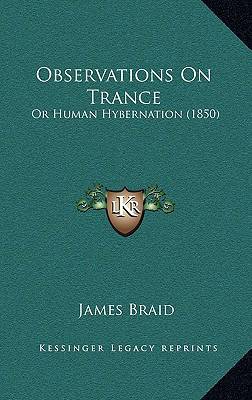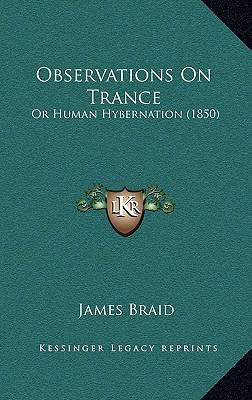
- Afhalen na 1 uur in een winkel met voorraad
- Gratis thuislevering in België vanaf € 30
- Ruim aanbod met 7 miljoen producten
- Afhalen na 1 uur in een winkel met voorraad
- Gratis thuislevering in België vanaf € 30
- Ruim aanbod met 7 miljoen producten
Zoeken
€ 47,45
+ 94 punten
Uitvoering
Omschrijving
Observations on Trance: Or Human Hibernation is a book written by James Braid in 1850. Braid was a Scottish surgeon and hypnotist who is credited with coining the term ""hypnosis"". In this book, Braid presents his observations and theories on the phenomenon of trance and its relation to hypnosis. Braid begins by defining trance as a state of altered consciousness that can be induced through various means, such as staring at a fixed object or repetitive verbal suggestion. He then goes on to describe the physical and mental changes that occur during trance, such as increased suggestibility and decreased awareness of external stimuli. Braid also discusses the potential therapeutic uses of trance, such as in the treatment of nervous disorders and pain management. He argues that trance can be a powerful tool for healing, but only when used responsibly and under the guidance of a trained practitioner. Throughout the book, Braid draws on his own experiences as a hypnotist and his observations of others in order to support his theories. He also addresses common misconceptions about trance and hypnosis, such as the belief that it is a form of mind control or that it can be used to extract secrets from unwilling subjects. Overall, Observations on Trance: Or Human Hibernation is a landmark work in the history of hypnosis and a fascinating exploration of the human mind.This scarce antiquarian book is a facsimile reprint of the old original and may contain some imperfections such as library marks and notations. Because we believe this work is culturally important, we have made it available as part of our commitment for protecting, preserving, and promoting the world's literature in affordable, high quality, modern editions, that are true to their original work.
Specificaties
Betrokkenen
- Auteur(s):
- Uitgeverij:
Inhoud
- Aantal bladzijden:
- 74
- Taal:
- Engels
Eigenschappen
- Productcode (EAN):
- 9781168873484
- Verschijningsdatum:
- 10/09/2010
- Uitvoering:
- Hardcover
- Formaat:
- Genaaid
- Afmetingen:
- 152 mm x 229 mm
- Gewicht:
- 281 g

Alleen bij Standaard Boekhandel
+ 94 punten op je klantenkaart van Standaard Boekhandel
Beoordelingen
We publiceren alleen reviews die voldoen aan de voorwaarden voor reviews. Bekijk onze voorwaarden voor reviews.











